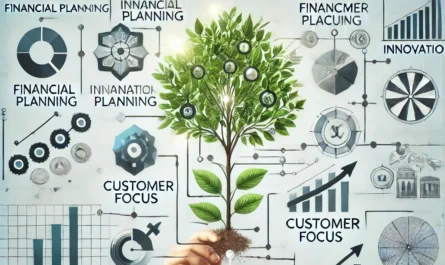Customer feedback is often considered the lifeblood of business growth. Listening to your customers is not just a good practice, it is essential for survival in today’s fast-paced, competitive marketplace. Understanding how to leverage customer insights can lead to strategic improvements that resonate deeply with your target market, fostering brand loyalty and driving long-term success.
Customer Feedback Business Strategy is all about translating the voices of your customers into actionable insights. When done correctly, it can significantly improve your product offerings, service delivery, and overall customer satisfaction. Let’s explore how you can effectively integrate customer feedback into your business strategy and harness its potential for growth.
The Importance of Customer Feedback in Business Strategy
Customer feedback provides a direct line of communication between your customers and your business. It’s an unfiltered way to understand what works and what doesn’t. This feedback offers invaluable insights into customer preferences, pain points, and expectations. By making it a cornerstone of your business strategy, you not only improve products and services but also enhance customer relationships.
Positive feedback highlights what you’re doing right, helping you to strengthen those areas, while negative feedback identifies areas that require immediate attention. Integrating both positive and negative feedback into your business operations ensures you maintain a balanced, well-rounded strategy for continuous improvement.
Types of Customer Feedback
Before diving into the “how” of using customer feedback, it’s crucial to understand the types of feedback you can collect. Each type offers different perspectives and can influence various aspects of your business strategy:
- Direct Feedback: This is explicit feedback provided through surveys, reviews, or direct communication like emails or phone calls.
- Indirect Feedback: Feedback gathered from customer behavior, such as usage patterns, click-through rates, or abandoned carts.
- Solicited Feedback: When businesses actively ask for feedback through surveys, NPS (Net Promoter Scores), or interviews.
- Unsolicited Feedback: Customer reviews, social media comments, or feedback received without the company directly requesting it.
Each type of feedback provides a piece of the puzzle, allowing businesses to form a more comprehensive understanding of their customer base.
How to Collect Customer Feedback
To successfully use feedback in your strategy, you must first ensure you are collecting it effectively. The methods of gathering feedback will vary depending on your industry, target audience, and available resources. Here are some effective ways to collect customer feedback:
- Customer Surveys: Design surveys to ask specific, actionable questions about the customer’s experience.
- Online Reviews: Monitoring platforms like Google Reviews, Yelp, or Trustpilot helps you understand public sentiment about your business.
- Social Media Monitoring: Social platforms are a goldmine for customer opinions. Use tools to track mentions and keywords related to your brand.
- Focus Groups: Hosting a focus group can give you real-time, in-depth feedback on specific aspects of your product or service.
- Website Analytics: Tools like Google Analytics can provide indirect feedback through user behavior and site performance insights.
Analyzing Customer Feedback
Collecting feedback is only half the battle. Once you’ve amassed customer insights, you need to analyze it thoroughly. Sorting through the data allows you to identify patterns, trends, and recurring themes. Here are steps to analyze feedback effectively:
- Categorize Feedback: Group feedback into categories such as customer service, product quality, pricing, etc., to identify key areas needing attention.
- Quantify the Data: If possible, quantify feedback by scoring satisfaction levels or frequency of certain comments. This gives you measurable data to work with.
- Identify Pain Points and Opportunities: Look for areas where customers are consistently dissatisfied. These represent your most significant opportunities for improvement.
- Prioritize Feedback: Not all feedback is equally important. Prioritize based on the potential impact of addressing certain issues on customer satisfaction and business performance.
Turning Feedback into Actionable Insights
Feedback is only useful if you can act on it. Once you’ve analyzed the data, the next step is to incorporate these insights into your business strategy. Here’s how to turn feedback into action:
- Revise Product Offerings: If feedback reveals consistent issues with a product or service, make necessary improvements.
- Enhance Customer Service: Customers often voice concerns about the level of service they receive. Address these concerns by training staff or updating service protocols.
- Adjust Pricing Strategies: Feedback on pricing can offer insights into whether customers feel they’re getting value for their money. Consider offering promotions or re-evaluating pricing models if necessary.
- Improve User Experience: Feedback from your website or app users can help improve design, navigation, or overall functionality to create a better customer experience.
- Refine Marketing Campaigns: Customers’ feedback about what resonates with them in your advertising can guide more targeted, effective marketing strategies.
Using Feedback for Innovation
Customer feedback is not just a tool for solving problems—it’s also a key driver for innovation. By listening to what your customers want or don’t even know they need yet, you can stay ahead of the competition. Here’s how to use feedback for innovative thinking:
- Product Development: Customers might suggest new features or enhancements that hadn’t been on your radar. Use this feedback to drive product development and offer something unique.
- Service Upgrades: If customers mention additional services they wish you offered, consider expanding your service offerings to meet this demand.
- Technology and Tools: Feedback on technological frustrations or preferences can help you upgrade your systems to offer a more seamless customer experience.
- New Market Opportunities: Sometimes, customer feedback can hint at underserved markets or demographics you hadn’t previously considered.
Improving Customer Retention through Feedback
Customer retention is significantly influenced by how well you respond to their feedback. When customers see that their opinions are valued and lead to tangible improvements, they are more likely to remain loyal to your brand. Here’s how feedback helps improve retention:
- Show Customers You Care: Regularly communicate with customers to show them how their feedback is being implemented.
- Follow-Up on Changes: Once changes have been made, inform customers about the improvements and invite them to share their experience again.
- Build Trust and Loyalty: When customers see that their voices lead to action, it builds a sense of trust and loyalty that goes beyond just the product or service itself.
- Create a Feedback Loop: Always keep the conversation going. Create channels where customers can continuously share their thoughts and engage with your brand.
Integrating Feedback into Long-Term Strategy
Feedback should not be a one-time event but a continuous process that feeds into your long-term business strategy. Regularly reviewing feedback ensures that your business evolves with your customers’ needs and preferences. Here’s how to integrate feedback into a long-term business strategy:
- Continuous Monitoring: Establish a system where customer feedback is regularly monitored, analyzed, and reported.
- Strategic Adjustments: Use the data gathered to make real-time adjustments to your business strategy.
- Customer-Centric Culture: Foster a culture where everyone in the organization understands the value of customer feedback and actively seeks ways to incorporate it into daily operations.
- Feedback as a KPI: Make customer satisfaction and feedback part of your business’s key performance indicators (KPIs). This ensures that feedback is treated as a critical metric in business success.
Common Mistakes Businesses Make with Customer Feedback
While feedback is crucial, businesses can make mistakes in how they handle it. Avoid these common pitfalls:
- Ignoring Negative Feedback: It’s easy to focus on positive reviews, but ignoring negative feedback prevents real growth.
- Failure to Act: Collecting feedback without taking action on it creates frustration for customers and does more harm than good.
- Over-Surveying Customers: Bombarding customers with surveys or requests for feedback can lead to survey fatigue and lower response rates.
- Not Closing the Loop: If customers provide feedback, they expect some form of acknowledgment. Always follow up to let them know their feedback was received and is being considered.
You can also read; The Importance of Brand Consistency in Digital Marketing
Best Practices for Using Customer Feedback
To truly harness the power of customer feedback, follow these best practices:
- Listen Actively: Don’t just hear customer feedback; actively listen to what they are saying and try to understand the underlying issues.
- Be Open to Criticism: View negative feedback as an opportunity for growth rather than a setback.
- Implement Feedback Quickly: Act on the most critical feedback swiftly to show customers that you are serious about improving.
- Keep Communication Open: Maintain an open line of communication with your customers to ensure they feel heard and valued.
- Celebrate Successes: When feedback leads to positive changes, celebrate these wins with your customers. This helps build a stronger community and brand loyalty.



